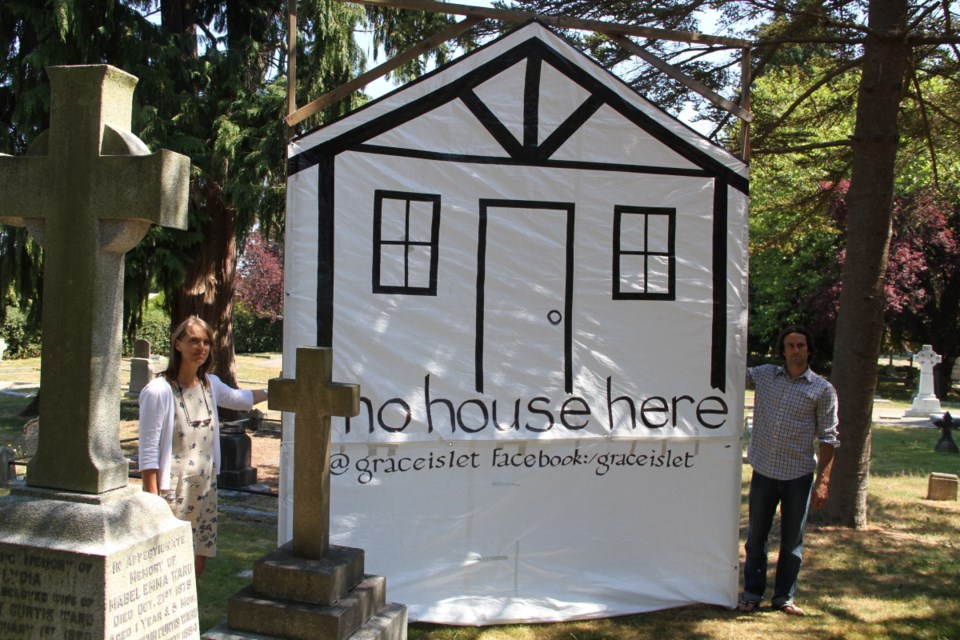Residents, politicians and First Nations opposed to a mansion being built over a burial ground on Grace Islet have in the past week erected “houses” over Victoria graves, asked B.C. to revoke permits and proposed expropriating the property for public use.
So far, the provincial government and the owner of Grace Islet have not responded to pleas for a compromise.
“I’m worried frustrations are starting to build, despite very reasonable requests, and that people might take matters into their own hands,” said Gary Holman, New Democrat MLA for Saanich North and the Islands.
The battle over the islet, in Ganges Harbour off Saltspring Island, began in 2006, when ancient human remains and First Nations burial cairns were discovered on the property.
Opposition has ramped up since construction began in 2012 and more recently as the home quickly takes shape.
Provincial archeologists in the 1970s marked Grace Islet as part of an ancient First Nations village. It later became privately owned and subdivided into a residential lot.
The 0.75-hectare piece of land was bought in 1990 by Alberta businessman Barry Slawsky, who is building a luxury home on the site. The owner has fulfilled all legal requirements.
“You’ve got government agencies pointing the finger at each other and the minister [Steve Thomson] says, ‘We’ve been through the process,’ ” Holman said. “What we need is some leadership here.”
On Monday, Saltspring residents opposed to the construction launched the #NoHouseHere campaign, placing a mock house over graves at Ross Bay Cemetery.
The graves belonged to ancestors of Briony Penn, the great-great-granddaughter of Montague Tyrwhitt-Drake, a former Victoria mayor, MLA and B.C. Supreme Court judge, and William Curtis Ward, founder of Douglas Lake Ranch.
Penn questioned provincial laws that protect her ancestors but not those of First Nations before colonization.
Because the Grace Islet burial site dates from before 1846, it is managed under the Heritage Conservation Act — not the Cremation, Interment and Funeral Services Act, which offers greater protection.
“There is a double standard and it has to end. First Nations have been fighting this uphill battle with government to protect their gravesites, culture and spiritual beliefs for far too long,” Penn said.
Capital Regional District directors sent a formal letter to the provincial government on Wednesday, asking it to revoke site alteration permits for Grace Islet issued by the archeology branch.
The letter cites concerns that First Nations were not consulted and asks that the site alteration permits be suspended to allow the CRD to put a stop work order on building permits.
Site alteration permits can be suspended only if new information comes to light, the application contained false information or the holder breaches the permit conditions, said Greig Bethel, a spokesman for the Ministry of Forests, Lands and Natural Resource Operations.
“There is no existing reason for the ministry to rescind or suspend the permit,” Bethel said.
The conditions were breached once in 2012, when excavation took place too close to the cairns and remains. Bethel said the permit was not revoked because none of the cairns were damaged and an archeologist was hired to oversee construction.
Branch representatives have not been to the site since 2013, but plan to visit in a few weeks, Bethel said.
CRD director Ben Isitt, who introduced the motion to send the letter, has also issued notice for a motion to expropriate Grace Islet. The motion will be discussed in-camera at an August meeting.
“The CRD is within their authority to acquire land for public use,” said Isitt, a Victoria councillor. “If local governments will expropriate land for highways, schools and other civic uses, surely we can acquire title for a burial ground.”
If expropriation were to proceed, Isitt said, Slawsky would be compensated at fair market value and funds could come from government and philanthropic sources.
Cowichan Tribes Chief William C. Seymour also sent a letter to Thomson this week outlining concerns about the construction, which he said is far more invasive than previously thought. He noted a lack of consultation with local First Nations and concerns about breaches of site alteration permits.
“Our ancestors should not be trapped in concrete. They were laid to rest on this islet for a reason,” Seymour wrote.
First Nations elders planned to walk to the islet during low tide on Wednesday for a ceremony. They requested permission from the owner through the archeology branch, but were refused access.
“It’s very frustrating, but no action will escalate without the elders’ blessing, and they are very respectful,” said Joe Akerman, a Saltspring Island resident with Cowichan Tribes heritage who kayaks around the islet drumming several times a week.
Slawsky has not responded to requests for comment.
This story has been edited from a previous version



